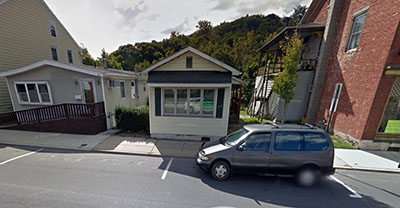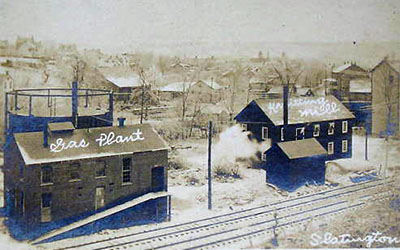In the area to the immediate west of the Main Street bridge, beyond the Slatington News building and beyond the Crystal Knitting Mill, was the Slatington Gas Company.
After James G. Rauch, the owner and publisher of The Slatington News, had purchased the entire tract of land north of the main Street bridge, west of Trout Creek and east of the Slatedale Branch of the Lehigh Valley Railroad, he then offered to sell off pieces of that property. For example, in August, The Slatington News carried an ad, “Factory site for sale,” “an excellent location for some manufacturing plant.” (18 August 1900) One tract of land became the site of the Crystal Knitting Mill.
Then in June 1901, the Slatington Gas Company purchased a 600 ft. x 200 ft. tract of land to the est of the Crystal Knitting Mills. The company was incorporated that year as the Slatington Gas Heating and Power Company with Walter L. Jones (president) and included other individuals such as James L Foote, Milton P. Schantz, J. W. Richards, Guy R. Jones, William B. Schaeffer and James L. Marsteller. Jones (1840-1913) was an important alderman in Allentown for over thirty years.
It did not take the company long to be up and supplying gas in the town. The borough council approved the use of town water by the company, and by February 1902 the company was producing gas. The company’s first office was located on Upper Main Street over the rooms of the Carbon Slate Company, and the first manager was Jacob Bumgardner (1848-1902), of Staunton, VA, who moved to Slatington to become superintendent of the new gas company. He was the son-in-law of Walter Jones, president of the company.
The gas produced and distributed by the company was called “manufactured gas.” It was made using the “Carburetted Water Gas Process.” In simplified terms, coal was heated to drive off coal gas. (The remaining solid left behind was primarily coke that could be used in steel-making.) That gas was then mixed with oil (in vapor form), superheated and cleaned (or scrubbed). The result was a gas with a much higher thermal value. For a decsription of the process, see, for example, www.bayshoreworksmgp.com/aboutmgps.html.
In February 1911, the gas company went into receivership with the court appointing Harry Graham as the receiver. After lengthy legal proceedings involving the Lehigh Valley Trust Company, on Saturday, 9 March 1918, the company was sold. The equipment listed at the time included about four miles of mains, meters, connections to about 500 customers, a gas holding tank of about 25,000 cubic ft. and oil tanks of about 15,000 gallons. The buyers, all from Allentown, were John L. Cutshall, Edwin R. Snyder and Frank M. Cressman with a winning offer of $3,000. They formed a new corporation with Frank Cressman as president and capital stock at 35,000.

Circa 1920 view of the gas company's gas holding tank
In January 1919, two men from Slatington, H. A. Muschlitz who was burgess at the time (and the man who had started the Crystal Knitting Mill) and S. B. Costenbader purchased the gas plant.
In the following decades, the company was reorganized and would change hands several times. There would also be some improvements made.
In September 1930, the corporation, through Henry Costenbader the general manager and treasurer, was sold to Baker Young and Co, a large Philadelphia gas firm. The new owners intended to extend the gas mains further in town and also to Palmerton. The office was set up at 624 Main Street in the Jones Building.
In March 1945, the plant was thoroughly modernized. A new gas holding tank about 60 ft. in length with a capacity of 16,000 gallons was installed. Gas was no longer be manufactured on site, but brought in via railroad tank cars. That gas would be processed and mixed at the plant. Basically, at this point in time, the company was now distributing propane gas. Cylinders could also be filled at the plant. At about this time, the Slatington Gas Company was being operated out of Whipany, NJ by the Suburban Propane Gas Company. It was estimated that there were almost six hundred customers in town.
On Friday, 13 September 1957, there was a major gas explosion that resulted in a fire that destroyed three houses and damaged a fourth at 261-263 and 267-269 Main Street. Fourteen people were homeless; three people were slightly injured. The damages were estimated at $28,000. On further investigation, the state police fire marshal and a safety engineer for the Suburban Propane Gas Co. determined that gas had leaked from a corroded section of a pipe leading into the basements of the buildings at 261 and 267 Main Street. The gas fumes ignited when an oil burner started. (For additional details and some eye-witness accounts, see Slatington at 150 Years: More Stories to Share (2014), pp. 343-344.)
In 1958-59, there were several law suits that resulted from this explosion for damages against Suburban Propane Gas Co. and its subsidiary the Slatington Gas Co.

Current view of the site of the 1957 gas explosion.
In August 1959, the Slatington Gas Corporation was purchased by C. Macdonald Swan, president of the Pennsylvania Gas Management Corp of Tamaqua, and the following year, the gas company switched over to natural gas obtained via a gas pipeline from Louisianna. This meant that with the switch from manufactured gas to propane and then to natural gas, the former gas company building was no longer needed. Eventually, the Pennsylvania Gas Management Corp. expanded to operate gas companies in Jim Thorpe, Lehighton, Palmerton and Slatington. Gas service was also extended to Walnutport and Lehigh Township. In December 1967, the Slatington gas office closed, and all business was transferred to the Lehighton office.
In April 1969, the Union Gas Company, a subsidiary of Penn Fuel Gas Inc of Oxford, Chester County, established control over the Slatington Gas Company and the other local gas firms.
Sometime, circa 2000, the old gas building was demolished. It is not clear if any environmental remediation took place at the site.
Since we all played in this area as kids, we were very familiar with the old gas building that was clearly abandoned and boarded up. You couldn't really see anything inside. I do remember picnicing on the old foundations of the gas tank!

Current site 2024, photo credit Christine Dieter
